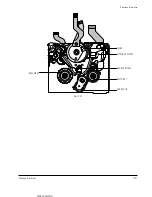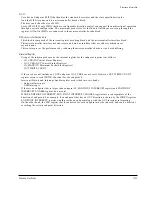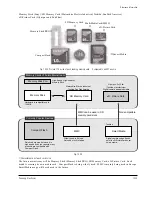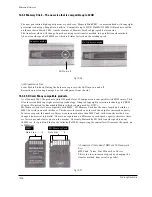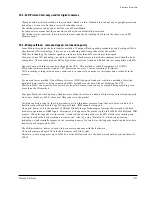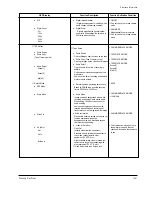
Reference Information
14-30
Samsung Electronics
14-2 PC INTERFACE
14-2-1 What is “USB”?
USB is the acronym for UNIVERSAL SERIAL BUS.
The objective of a USB is to make it universally applicable to all peripherals, and data is transmitted in series.
The USB, which a compact and simple interface as well as a thin cable can resolve everything, has two wires
for the electricity and two for the transmission inside the cable. Since there are only four wires passing through
it, the cable is thin and the terminal is small.
14-2-2 Advantages of USB
1) A USB peripheral can be connected easily, and the device can be automatically recognized once it is plugged
after the drive is installed. It is possible to connect or remove the device while using Windows, and save the
system resource such as insufficient IRQ or address.
2) Plug & Play and Hot-plugging: Because Plug & Play is supported, turning the PC off and on is not necessary
when changing peripherals. And hot-plugging is also supported. Plug & Play means when connecting a
peripheral to a PC, it automatically recognizes the device.
Hot-plugging means that it’s always possible to connect or remove the device while a PC is running.
3) USB and Windows: USB is only compatible with Windows. As for Windows 95 version OSR2.1 or higher is
required for a normal operation. It is preferable to at least have Windows 98.
If the OS is Linux or Windows 95 version OSR 2 or lower, USB peripherals, USB LAN cards, USB Internet link
cables, etc. cannot be used. When two PCs are connected and one of them has Windows 95 or lower or Linux as
the operating system, it is not possible to use USB devices.
4) Effective Use of Resource: Currently, the number of IRQ (Interrupt ReQuest) in a PC is restricted to 16.
However there are only 9 that are actually usable. Among them, 2 are reserved for IDE (Integrated Drive
Electronics), 2 for serial ports, and 1 for a parallel port. That leaves only 4 usable IRQs. Nonetheless, a USB can
connect 127 peripherals for use at one IRQ. It connects the mouse with the keyboard, the keyboard with the
printer, etc. as if to link them altogether, so things like not having enough ports or entangled cables do not
happen.
5) Fast Data Transmission: USB can transmit data up to 1.5MB (12 Mbps) per second, but the actual transmission
speed is about 0.8 - 1.2 MB/s. It is because a peripheral can only use 40 - 60% of the resource so that the
resource is not exclusively occupied by a certain device when there are several ones.
The maximum data transmission speed of a serial port is 20KB/s, and it is 400 - 600KB/s for a parallel port.
USB is twice faster than a serial or parallel port.
CPU possession rate also affects the transmission speed. A zip drive that uses a parallel port needs a lot of CPU
power when writing a file on a drive and it is so slow to make the movement of the mouse slow.
Compared to a parallel port, using a USB reduces the CPU possession rate, and the speed is astonishingly
faster.
6) Peripherals: There are increasing numbers of peripherals that use USB as a basic interface.
More and more internal devices, such as a modem, are changing to an external USB devices.
Almost all the devices that are connected to the external of a PC have a USB port.
Printer, scanner, keyboard, mouse, joystick, game pad, video camera, still image camera, modem, internet
adapter, external storage device, etc. are among them. There are also connectors to connect existing peripherals
that are in a different connection mode to a USB. For example, using connectors such as USB to IDE, USB to
PS/2, USB to printer, USB to serial port makes it possible to use peripherals as if they were USB devices.
14-2-3 Disadvantages of USB
It can only be used in the Windows environment, and the electricity is restricted to 5V, 500mA.
The standardization of connectors is yet to be done. Therefore, different connector manufacturers produce
connectors with different looks, which makes it difficult to have connecter compatibility.
Содержание SC-D362
Страница 14: ...Product Specification 2 6 Samsung Electronics MEMO ...
Страница 48: ...4 18 Disassembly and Reassembly Samsung Electronics MEMO ...
Страница 70: ...Exploded View and Parts List 5 22 Samsung Electronics MEMO ...
Страница 91: ...Samsung Electronics 8 1 8 Wiring Diagram ...
Страница 92: ...Wiring Diagram 8 2 Samsung Electronics MEMO ...
Страница 102: ...PCB Diagrams 9 10 Samsung Electronics MEMO ...
Страница 168: ...Operating Instructions 11 46 Samsung Electronics MEMO ...
Страница 180: ...Troubleshooting 12 12 Samsung Electronics MEMO ...
Страница 200: ...Circuit Operating Description 13 20 Samsung Electronics MEMO ...












